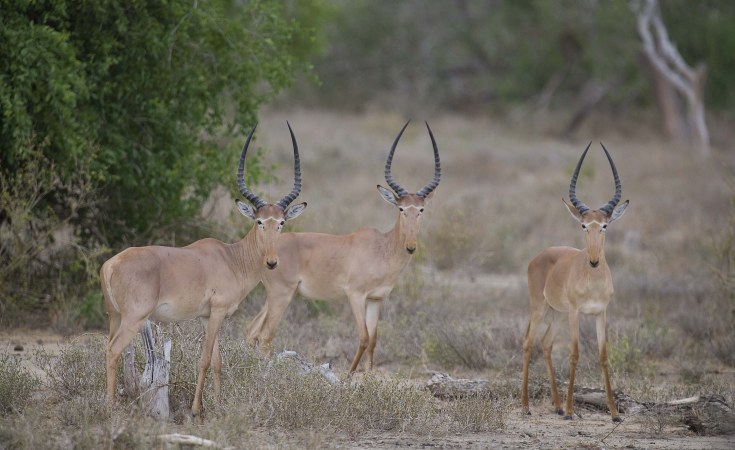Nairobi — While the world focuses on the African Union effort to oust Al Shabaab militants from Somalia, another operation is quietly plugging away along the country's southern border with Kenya.
But instead of international forces and Islamic extremists, this one involves a leading conservationist, Chinese funders, a handful of helicopters and group of pastoralists. Their mission? To save the hirola antelope, one of the rarest large mammals on the planet, according to M. Sanjayan, lead scientist at the U.S.-based Nature Conservancy.
This unlikely team joined forces in August to net, tranquilize and airlift 24 of the tawny-colored ungulates to a newly built sanctuary in northern Kenya. Another 24 entered of their own accord for a base population of 48.
The hirola is the last living representative of the Beatragus hunteri genus. If this animal with the long muzzle and trademark white-spectacle markings dies, the entire three-million-year-old lineage goes too.
The situation is grave. Experts pin the remaining population between 350 and 450. The antelopes are more rare than giant pandas, mountain gorillas and rhinos, according to Sanjayan. And if these few hundred die off, the hirola would be the first genus of mammals to become extinct in Africa during modern times, he says.
But saving the hirola is not as easy as crating a few up and shipping them to a zoo for safekeeping. They don't breed well in captivity. "You have to save them in the wild or you don't save them at all," Sanjayan says.
So the Nature Conservancy, the Northern Rangelands Trust, Flora and Fauna International and a group of Somali pastoralists devised a plan to cordon off a wildlife conservation area in prime hirola territory. The result? The Ishaqbini Hirola Community Conservancy, a park in northern Kenya's Ijara District that encompasses a 100-strong population of hirola.
But even after this effort the hirola population failed to recover.
Predators such as lions, cheetahs, hyenas and leopards were eroding antelope numbers. "When you're down to 350 animals, the loss of one or two is a huge deal," Sanjayan says.
The conservation groups and pastoralists returned to the drawing table and, with the financial backing of Chinese trustees, fenced in 7,000 acres to create a predator-free sanctuary within Ishaqbini. More than 40 hirola were flown in by helicopter to breed. If all goes as planned and the population swells to more than 100, the conservancy will start returning them to the wild in groups of 10 or 20, Sanjayan says.
Still relatively new, the project's success remains to be seen. The animals are still vulnerable to fire and disease – a single incident could wipe out the entire population.
But the sanctuary already offers something of value – an opportunity to see one of the rarest large animals on earth. The team plans to make the sanctuary self-sustaining by capitalizing on this through exclusive tourism opportunities. However, the park's close proximity to Somalia has kept many potential wildlife watchers at bay, Sanjayan says.
Then there's the challenge of incentivizing local herding communities to accommodate the hirola on potential pastureland. The tradeoff favors the antelopes in this scenario, according to Sanjayan.
The land around the conservancy is dry and supports few cattle. The hirola, on the other hand, offer a "boon". "Local communities have this rare and potentially famous species at their doorstep… nowhere else on the planet can you get this, so it could really give them something," he says.
That may explain why preserving the hirola is important for local communities, but why should donors, policymakers and those in far-flung countries care?
"It matters because Africa is the last realm of really great mammalian diversity," Sanjayan says. "If you want to see birds go to South America, if you want to see big mammals you come to Africa, and to lose one – the first one, the first big mammal, the first entire genus – during our watch - would be a dreadful shame."


